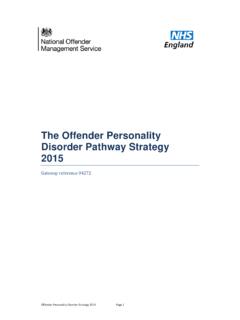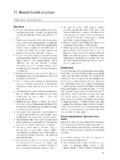Transcription of THE CAUSES OF DELINQUENCY - University of New Mexico
1 INSTITUTE FOR SOCIAL RESEARCH University OF NEW Mexico Working Paper No.: 2 THE CAUSES OF DELINQUENCY Prepared for the Criminal and Juvenile Justice Coordinating Council January, 1996 NOTE: This working paper provides research information for the New Mexico Criminal and Juvenile Justice Coordinating Council It is not a statement of the Council's views or opinions. INSTITUTE FOR SOCIAL RESEARCH Research Team for this Working Paper Marie Clevenger, : Research and writing. Sections 1 and 2 Christopher Birkbeck, : Research and writing, Sections 1 and 3 Table of Contents I Introduction 1 II The CAUSES of DELINQUENCY INDIVIDUAL PROBLEMS Early biological theories Modem biological theories Psychological theories SOCIALIZATION PROBLEMS Inappropriate Values Differential association Differential reinforcement Neutralization theory Weak Links to Conventional Society Negative/Deviant Self Images SOCIETAL PROBLEMS Social disorganization Poor Social/Community Integration Lack of Opportunities for Legitimate Advancement Plural Society, Different Values Opportunities for Crime Lack of Accountability INTEGRATED THEORIES Elliott and Ageton, Glazer Wies 3 3 3 3 4 5 5 5 5 5 6 7 8 8 8 9 9 10 10 12 12 12 12 III USING THEORY TO THINK ABOUT POLICY "RESTORING JUSTICE" AND THE CAUSES OF DELINQUENCY How important is the question of the CAUSES of DELINQUENCY ?
2 What kinds of CAUSES of DELINQUENCY ? Some discussion questions 14 15 15 16 17 IV BIBLIOGRAPHY 18 APPENDIX I 21 Page FIGURE 1: CAUSES and Theories of DELINQUENCY 2 FIGURE 2: A Model for Integrating Different CAUSES of DELINQUENCY 13 I. INTRODUCTION Recent research indicates that a majority of people view crime as one of the most pressing of current social problems (Senna and Siegel 1995). Of particular concern is the increase in violence among young people. Valuable information is provided by the Uniform Crime Report and self-report studies. For example, we know that approximately half of all arrests involve persons under the age of twenty-five. While the overall arrest rate for juveniles has increased by percent since 1982, arrests for violent crimes such as aggravated assault, robbery, rape and homicide have increased by 41 percent (Regoli and Hewitt 1994).
3 Gender plays an important part. The overall arrest rate for males is four times greater than for females. Young men are eight times more likely to be arrested for violent crimes than are young women (Regoli and Hewitt 1994). Given the significant social concern surrounding the problem of juvenile DELINQUENCY , it is natural and reasonable for policy makers, academics and citizens to ask what might cause DELINQUENCY . If the factors that lead to the onset, increase or continuation of delinquent behavior could be successfully identified, then we would have a clearer idea of what might be done to prevent DELINQUENCY . In addition, we might also gain a better sense of the limits to our ability to reduce DELINQUENCY through purposeful intervention. Asking what CAUSES DELINQUENCY is much easier than providing the answer.
4 For example, although we know that the highest rates of DELINQUENCY behavior are found among males aged 15 to 17, we do not know why that group is the most delinquent. Gender and age are relatively good predictors of delinquent behavior, but they are not CAUSES of DELINQUENCY , in any meaningful sense of the word; and for that reason, they do not give any clear indication of what we might do to prevent DELINQUENCY . We cannot, for example, remove all males aged 15 to 17 from society. Many people have their particular ideas about factors that might cause DELINQUENCY , and researchers have also unearthed many possibilities. For example, some think that poverty is the cause of DELINQUENCY , others that families are the problem, still others that unsuitable friendships are a major contributor.
5 While some support can be found for each of these positions, we are not always much closer to the goal of understanding juvenile DELINQUENCY . For example, to argue that unstable or conflictive families are associated with DELINQUENCY still leaves many questions unanswered. How does family instability or conflict affect juveniles? Precisely when do instability and conflict lead to delinquent behavior? Are instability and conflict associated with specific kinds of delinquent behavior? Thus, naming the factors that are thought to be associated with DELINQUENCY does not necessarily help us to design prevention or intervention programs that have some chance of being successful. One of the main concerns of criminologists is to address the problem of causality, and even a brief review of criminological research shows that, as with all things social, establishing causal pathways is a complicated process.
6 Ethical concerns involved in the study of human beings often render the use of controlled experimental conditions, impossibility in the study of crime. The result is that isolation of pertinent variables can often be difficult. In addition, definition of the question to be answered is often more complicated than it appears at first glance. Although related, crime and criminality are different concepts. Gottfredson and Hirschi (1990) point out that different variables may be involved in trying to answer the question of what CAUSES crime versus what CAUSES criminality. The latter involves an investigation of the factors that make one person more likely to commit crime than another. The answer to the former is based on variables, such as situational motivation and opportunity (Birkbeck and LaFree 1993, Felson 1994).
7 Nevertheless, criminologists have made some headway in identifying different types of cause, and causal process, that might lead to delinquent behavior. The main types of cause are often expressed in more abstract terms than those usually employed by policy makers or citizens. However, those CAUSES are frequently the implicit or explicit focus of DELINQUENCY prevention or intervention programs. Some CAUSES refer to individual characteristics, others to the socialization process, and still others to social system characteristics. Each type of cause is addressed by one or more theories that link, with varying degrees of precision, the cause to criminal behavior. Figure 1 shows the main kinds of cause studied by criminologists, and the theories that propose the links between each cause and delinquent behavior.
8 The first part of this paper describes these CAUSES , as articulated in the corresponding theory. The second offers some ideas on the links between theory and policy, and develops a brief case study focusing on the most recent initiative in New Mexico 's juvenile justice policy: "Restoring Justice." Figure 1: CAUSES and Theories of DELINQUENCY CAUSES Theories INDIVIDUAL DIFFERENCES Physiological problems Personality problems INDIVIDUAL THEORIES Biological theories Psychological/Psychoanalytic theories SOCIALIZATION PROBLEMS Inappropriate values Weak links to conventional society Negative/deviant self-images PROCESS THEORIES Differential Association, Differential Reinforcement, Techniques of Neutralization Social Control Theory Symbolic Interaction/Labeling SOCIETAL PROBLEMS Poor social/community integration Lack of opportunities for legitimate advancement Plural society, different values Opportunities for crime, lack of surveillance, etc.
9 Lack of accountability STRUCTURAL THEORIES Social Disorganization theory Anomie, Strain theories Cultural theory Routine Activity theory Deterrence theory II THE CAUSES OF DELINQUENCY INDIVIDUAL PROBLEMS Early biological theories of crime were based on the premise that those who engage in criminal behavior possess anomalies in their physical constitution that make them different from the population of non-offenders. The theories focused on the individual as the unit of analysis. The role of social variables was considered to be minimal (Akers 1994). These theories, which became popular toward the end of the nineteenth century, were based on positivism, the use of scientific method and empirical analysis to study behavior. One of the earliest of the theorists was Cesare Lombroso. In 1876, Lombroso published a work entitled The Criminal Man, which was to influence subsequent biological theories.
10 Lombroso' s work included the observation of the physical characteristics of two groups of Italian men. A group of prisoners was compared to a group of soldiers. From his observations, Lombroso concluded that certain physical traits could be used to identify persons with an innate predisposition to engage in criminal activity. These were the "born criminals." Lombroso considered them to be throwbacks to a more primitive stage of human evolution. As such, these persons were unsuited to life in modem society (Akers 1994, Siegel 1992). Although Lombroso and others such as Goring and Hooten attempted to employ scientific method in the study of crime, it is generally recognized that the early studies were plagued by methodological problems. Control groups were not used, so comparison of the experimental groups with the general population was impossible.








